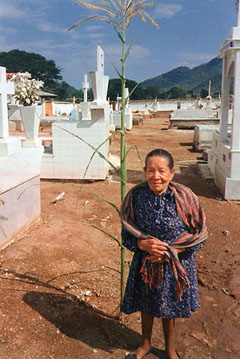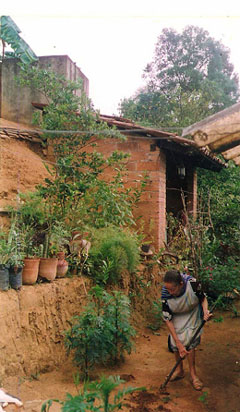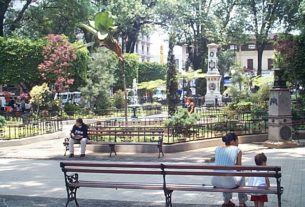At Home in Talpa de Allende, Jalisco

© Jenny McGill, 2009
Victoria Cibrian Leon, born March 23, 1916, was the oldest girl in a family of eight children. She only had two brothers; Eziquiel and Primitivo. Toyita, as she was fondly called, never got beyond the first grade of school.
When she was six years old, while playing rough and tumbling with neighborhood kids, she fell and broke her back. There were no taxis or ambulances in Talpa in those days. In fact, there were very few vehicles of any kind, but her parents managed to hire someone with a pickup truck to take her to the nearest hospital, which was in Guadalajara. That was approximately a ten hour ride over a bumpy, unpaved, curvy mountainous road. I only can imagine the agony of that little girl lying on a pallet of old quilts in the back of that bouncing pickup, perhaps with her head in her mother’s lap.
The old-time common treatment for broken bones was much as it is today, yet more primitive. Wooden splints and plaster of Paris were available, but they had not yet figured out how to make body casts or use traction. Modern medicine leans toward surgery, metal plates and screws to put a bone back together, but that wasn’t done in Toyita’s time. The best the doctors could offer was to strap her to a wooden board for six months to a year.
She was a young girl; hurt, but wanting to be active. The parents decided to let her heal the best she could, so she ended up being a four-foot humpback.
As in so many Latin American homes in the 1800s and on into the nineteenth century, at least one daughter in the family stayed home and never married. That daughter’s responsibility was to cook and care for the parents as they grew older and infirm. Toyita chose to play that role in her family.
Actually, she was one of the best cooks I’ve ever met, including those women in my own family. Her original kitchen was close to, but separate from the main house. It was a three-sided adobe brick lean-to covered with red clay tile shingles laid over wooden rafters. From this ceiling, Toyita hung her kitchen herbs for drying. The cook top was made of adobe brick with iron rods laid in place to support the cooking vessels. It didn’t have back burners and front burners. There were four burners laid out in a row side by side. Each cooking spot was individual, and had its own place underneath the iron bars to build a little fire. I don’t know what the logic was behind this except maybe to conserve wood or to control the heat. Perhaps a fire hot enough to boil beans is a bit too hot to fry a sunny-side-up egg. Due to Toyita’s height, her cook top was built lower to the floor than our average kitchen counter top. A bee-hive shaped clay oven was built into one corner and that is where Toyita baked her bread and cakes.
By the time I entered the scene, she was cooking in a regular kitchen in the family home, although the original kitchen remained in its place until heavy rains brought it to the ground in 2004.She kept a small stool by the side of her four-burner gas stove in her regular kitchen. Even from that stool, she could barely reach up to stir the beans in their cooking pot. I could cook a pot of beans alongside her, snip the same fresh oregano or epazote from the back garden, add the same amount of salt at the same time she did and cook them the same amount of time. Mine always ended up just tasting like beans; hers tasted as if they had been cooked by the kitchen gods.
I used to ask her, “What did I do wrong, Toyita? Why are mine so different?”
“Es la mano, muchacha, es la mano,” she’d say. “It’s the hand, girl, it’s the hand.”

It must have been the hand. You’ve heard of people having green thumbs? She could almost make a rock grow. Her garden wasn’t very big, but it was filled with oregano, mint, rue, thyme, marjoram and cilantro. Dahlias, marigolds, begonias, geraniums, roses, bougainvilleas, zinnias and amaryllis bloomed in a hodge-podge glory in her garden. There was no attempt at a landscaping design. It just grew! I saw her cut up a head of cabbage for a coleslaw one day. She planted the core upright by my backdoor steps. The next time I came to town, there was a head of cabbage growing there! There were also several pineapples scattered around the garden. She rooted the tops in water and re-planted them to grow another pineapple.
There were papaya, lime and sweet lime trees growing in abundance. The sweet lime, called lima, is about the size of a small orange and is sweeter than the regular lime. Agua fresco or “fresh water,” like our lemonade or other fruit drinks are popular summer drinks.
As long as I lived next door to Toyita, she and I went to her garden bright and early every October 7th to cut flowers to carry to church for the designers to use in making the carpet for the Virgin to walk over in celebration of her birthday.
One year she had fought grasshoppers away from her dahlias all summer long and some of them had grown as big as saucers. Each of us carried a pair of scissors as we walked among her dew-laden flowers snipping red, yellow, fuchsia and orange zinnias; keeping a separate basket for the marigolds. The dahlia bed was near her back door. We snipped in the front garden and in the back garden. We snipped flowers in both side gardens. Each time we went from one side of the house to the other, we had to walk by her dahlia bed. I watched her from the corner of my eye. Every time we walked by the dahlias, she would give a little sniff, raise her head a bit higher and walk on to the next flower.
Finally, I asked her, “Toyita, are you not going to take your dahlias to church?”
She sniffed a bit louder, “Pues, son demasiado grandes.” “Well, they’re too big.”
“Too big? Too big for what? Those white petals will make a beautiful background for the colored flowers! You just want to keep them for yourself, don’t you?”
“They’ll have enough without these.”
I teased her, “I’m going to tell Father Corona you kept the best for yourself. What do you think the Virgin will think about that?”
Another little sniff and she walked inside to her kitchen, leaving the baskets of cut flowers on the veranda outside. A while later, her kitchen helper and I carried the baskets to church. On top of each basket were saucer-sized white dahlias with tips of the petals tinged pink.


